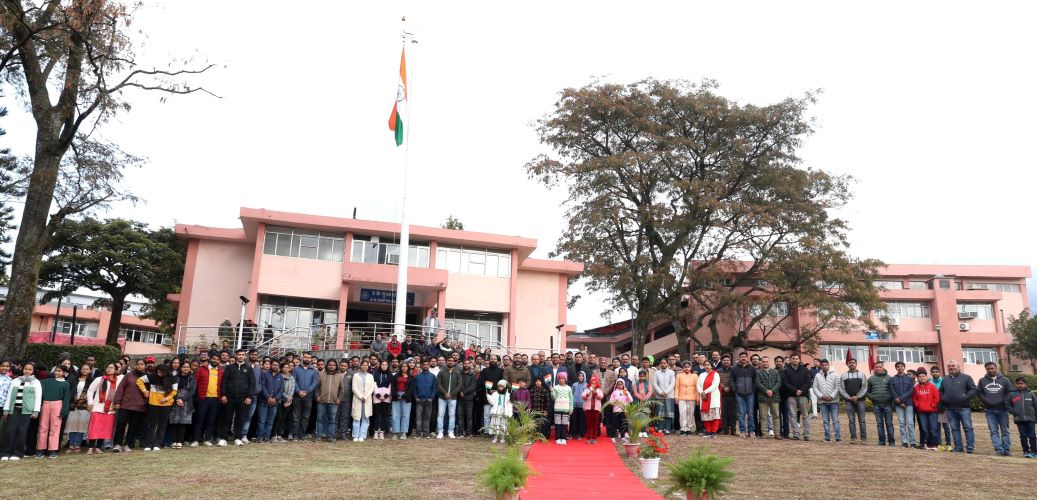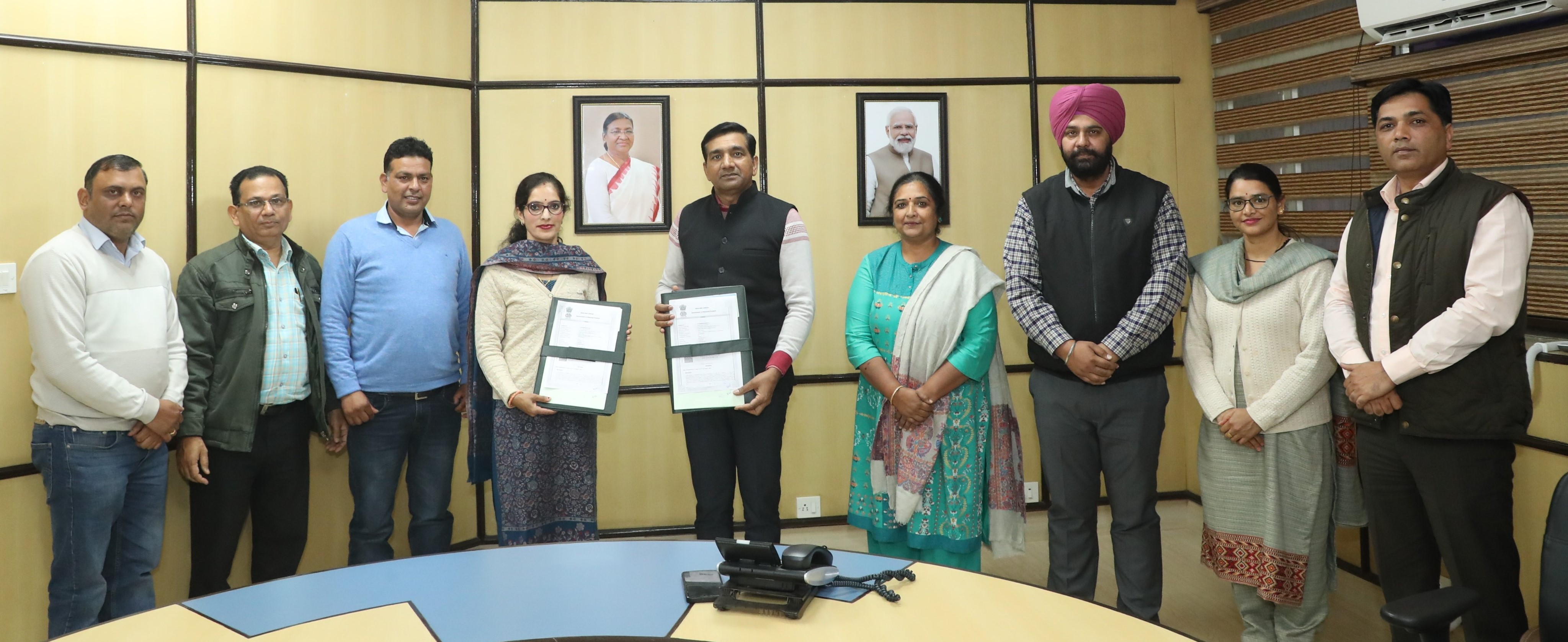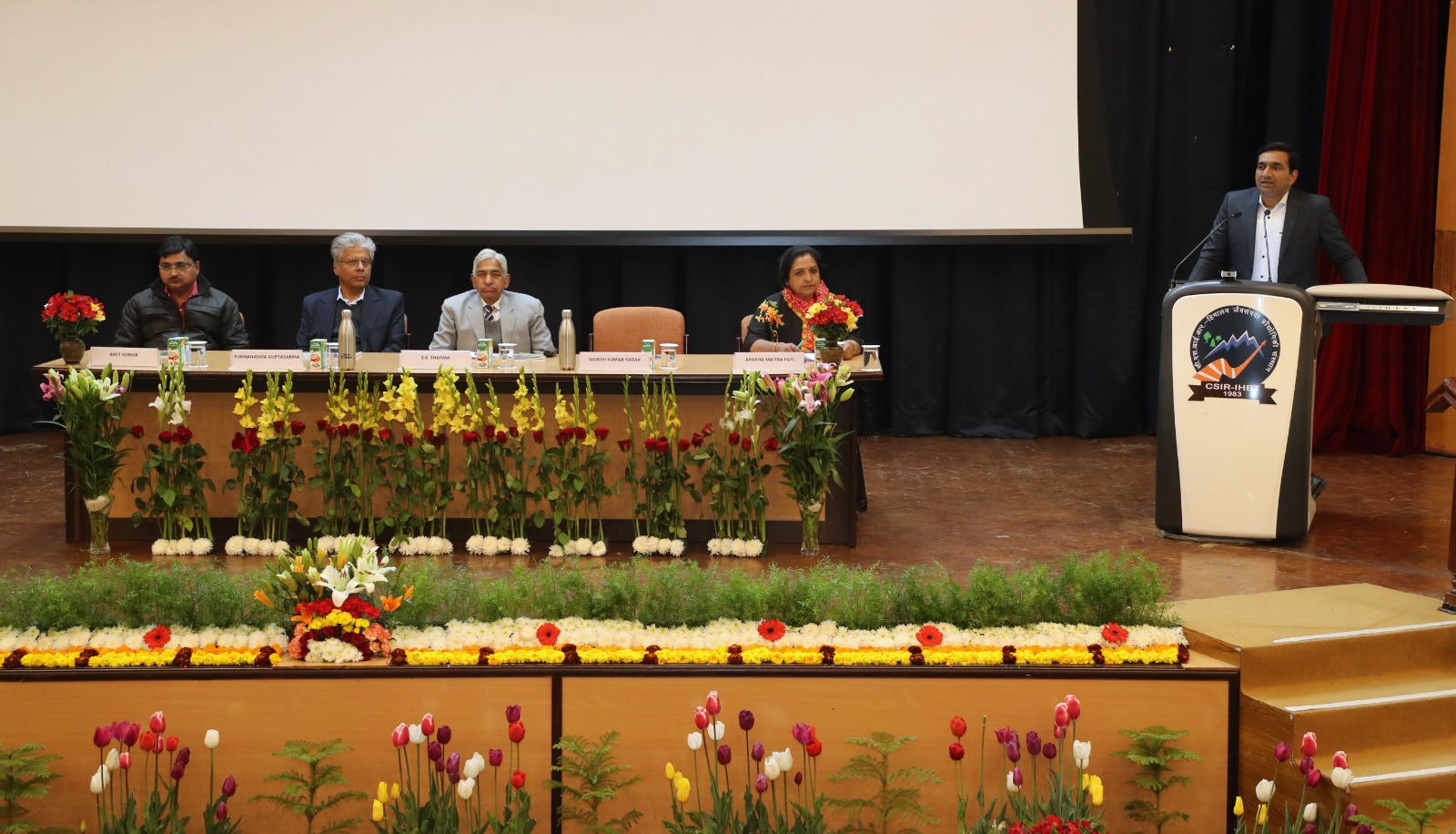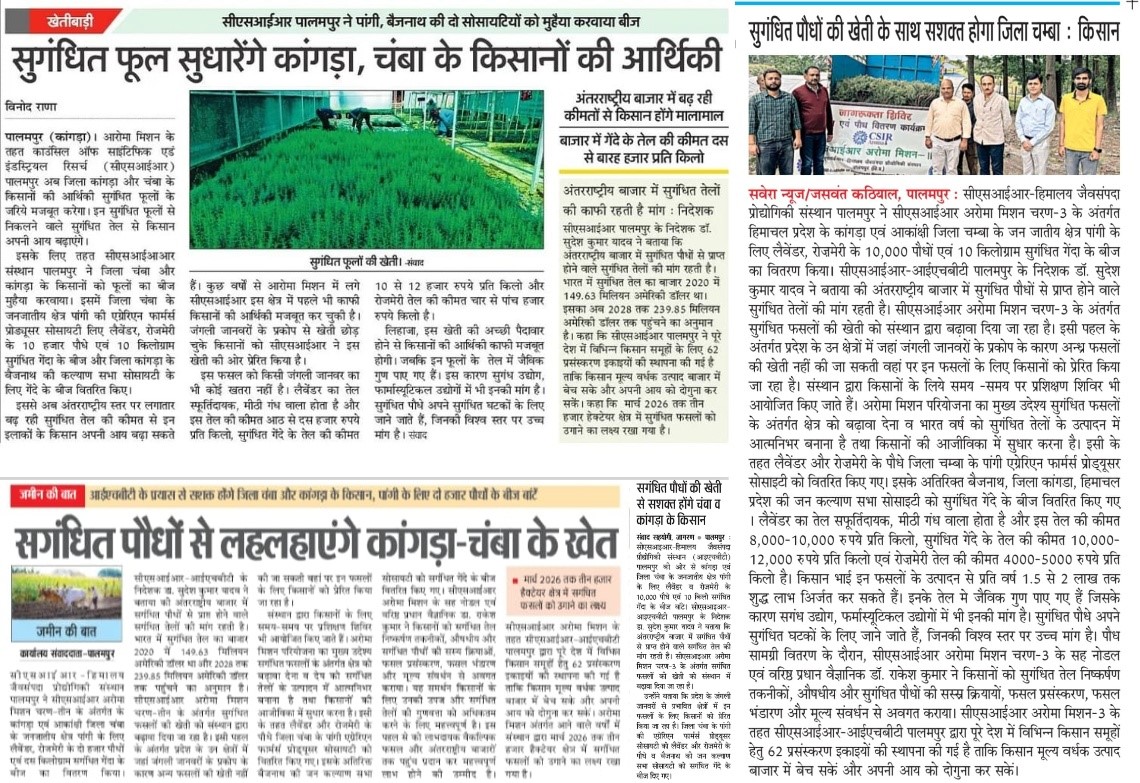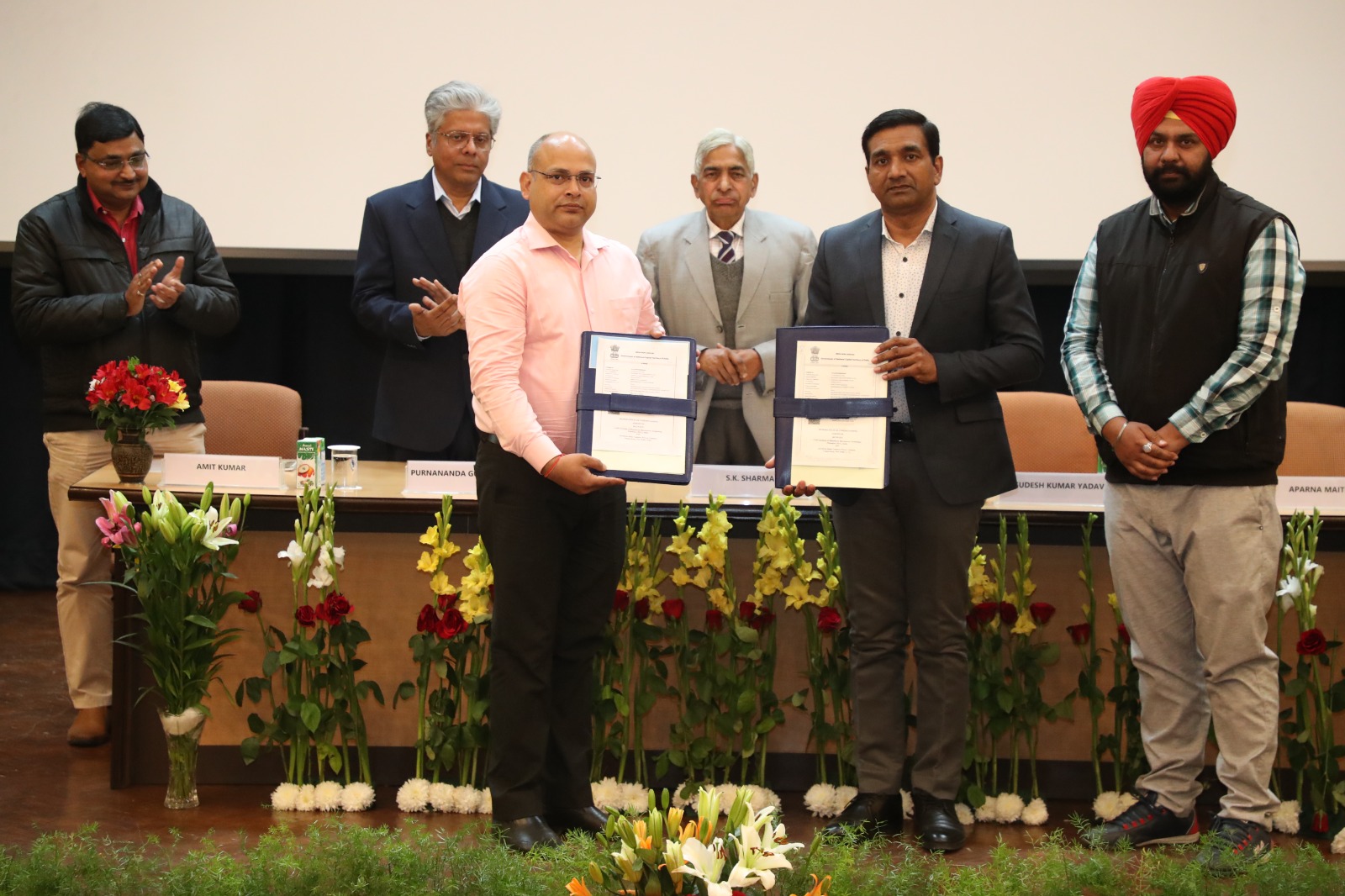


Dr N. Kalaiselvi
Director General, CSIR & Secretary DSIR

Dr. Sudesh Kumar Yadav
Director, CSIR, Palampur
CSIR-IHBT
Vision : To be a global leader on technologies for boosting bioeconomy through sustainable utilization of Himalayan bioresources
परिकल्पना: जैवार्थिकी के उन्नयन हेतु प्रौद्योगिकीय उद्भवता एवं विकास में हिमालयी जैवसंपदा के संपोषणीय उपयोग द्वारा विश्व स्तर पर अग्रणी होना
Mission : To discover, innovate, develop and disseminate the processes, products and technologies from Himalayan bioresources for society, industry, environment and academia.
उद्देश्यः सामाजिक, औद्योगिक, पर्यावरणीय और अकादमिक हित हेतु हिमालयी जैवसंपदा से प्रक्रमों, उत्पादों और प्रौद्योगिकियों की खोज, नवोन्मेष, विकास एवं प्रसार
read more
- NCW Helpline (24x7) for Women in Distress (+91-7827170170); The website for the helpline is www.ncwwomenhelpline.in
- CSIR-IHBT Technology based products available in the market
- Internal Complaints Committee (ICC) for Prevention of Sexual Harassment of Women at CSIR-IHBT, Palampur
- CSIR-IHBT invites Expression of Interest (EOI) for Ready to Transfer Technologies
- Price List (2023-24)
- List of shortlisted candidates to be called for Interview(s) for the posts of Scientists (Post Codes: SCT-2002 to SCT-2010) advertised vide Advt. No. 2/2020
-
Recent advances in the discovery of potent RNA-dependent RNA-polymerase (RdRp) inhibitors targeting viruses
Recent advances in the discovery of potent RNA-dependent RNA-polymerase (RdRp) inhibitors targeting viruses Recent
advances in the discovery of potent RNA-dependent RNA-polymerase (RdRp) inhibitors targeting viruses Recent advances in the discovery of potent RNA-dependent RNA-polymerase (RdRp) inhibitors targeting viruses Recent advances in the discovery of potent RNA-dependent RNA-polymerase (RdRp) inhibitors targeting viruses
-
Arthrospira platensis (Spirulina) fortified functional foods ameliorate iron and protein malnutrition by improving growth and modulating oxidative stress and gut microbiota in rats
Raman Kumar, Vinesh Sharma, Sampa Das, Vikram Patial and Vidyashankar Srivatsan
Abstract
The present study was aimed at developing Arthrospira platensis (Spirulina) fortified traditional foods of the Indian subcontinent, namely sattu (multigrain beverage mix) and chikki (peanut bar) and evaluating their ability to promote recovery from protein and iron deficiency anaemia (IDA) using albino Wistar rats. Addition of Spirulina (at 4% w/w Spirulina inclusion levels) enriched the protein content by 20.33% in sattu and 15.65% in chikki while the iron content was enhanced by 45% in sattu and 29.6% in chikki. In addition, the total carotenoid and polyphenol content and antioxidant capacity of the food products improved after Spirulina incorporation. Supplementation of 100 g of Spirulina fortified food products meets more than 50% of recommended dietary allowances (RDA) of protein, dietary fiber, iron and zinc for the age group 3 to 10 years of children. Spirulina contributed between 11% and 22% of RDA for protein and iron, respectively; however it contributed very negligibly to RDA of dietary fibre with respect to the nutrient requirements for the target age group. Supplementation of Spirulina fortified foods individually promoted bodyweight gain in malnourished rats and restored haemoglobin, serum protein, albumin, serum iron, and hepcidin levels and reduced the iron binding capacity indicating recovery from IDA. Spirulina supplementation ameliorated malnutrition induced oxidative stress in the liver, spleen and kidneys by reducing the lipid peroxidation and enhancing superoxide dismutase and glutathione activities. Histopathological analysis revealed that supplementation of Spirulina fortified foods reversed pathological changes such as fatty changes in the liver cells, thinning of cardiac muscle fibers and degeneration of intestinal villi. Fe–protein deficiency significantly altered the gut microflora by reducing the abundance of beneficial microbes. However, supplementation of Spirulina fortified foods improved the levels of beneficial gut microbes such as Lactobacillus reuteri and Akkermansia muciniphila while reducing the abundance of Helicobacteraceae, Enterobacteria and Clostridia. In summary, supplementation of Spirulina fortified foods promoted recovery from protein and iron deficiency indicating the bioavailability of nutrients (iron and protein) from Spirulina at par with casein and ferrous ascorbate.
Journal: Food and Function
-
Machine intelligence-guided selection of optimized inhibitor for human immunodeficiency virus (HIV) from natural products
Neeraj Kumar and Vishal Acharya
Abstract
The human immunodeficiency virus (HIV) connects to the cluster of differentiation (CD4) and any of the entry co-receptors (CCR5 and CXCR4); followed by unloading the viral genome, reverse transcriptase, and integrase enzymes within the host cell. The co-receptors facilitate the entry of virus and vital enzymes, leading to replication and pre-maturation of viral particles within the host. The protease enzyme transforms the immature viral vesicles into the mature virion. The pivotal role of co-receptors and enzymes in homeostasis and growth makes the crucial target for anti-HIV drug discovery, and the availability of X-ray crystal structures is an asset. Here, we used the machine intelligence-driven framework (A-HIOT) to identify and optimize target-based potential hit molecules for five significant protein targets from the ZINC15 database (natural products dataset). Following validation with dynamic motion behavior analysis and molecular dynamics simulation, the optimized hits were evaluated using in silico ADMET filtration. Furthermore, three molecules were screened, optimized, and validated: ZINC00005328058 for CCR5 and protease, ZINC000254014855 for CXCR4 and integrase, and ZINC000000538471 for reverse transcriptase. In clinical trials, the ZINC000254014855 and ZINC000254014855 were passed in primary screens for vif-HIV-1, and we reported the specific receptor as well as interactions. As a result, the validated molecules may be investigated further in experimental studies targeting specific receptors in order to design and synergize an anti-HIV regimen.
Computers in Biology and Medicine (IF 6.698)
-
The upsurge of lytic polysaccharide monooxygenases in biomass deconstruction: characteristic functions and sustainable applications
The upsurge of lytic polysaccharide monooxygenases in biomass deconstruction: characteristic functions and sustainable applications
Asheesh Kumar, Aishwarya Singh, Vijay Kumar Sharma, Akshita Goel, Arun Kumar
Abstract
Lytic polysaccharide monooxygenases (LPMOs) are one of the emerging classes of copper metalloenzymes that have received considerable attention due to their ability to boost the enzymatic conversion of intractable polysaccharides such as plant cell walls and chitin polymers. LPMOs catalyze the oxidative cleavage of β-1,4-glycosidic bonds using molecular O2 or H2O2 in the presence of an external electron donor. LPMOs have been classified as an auxiliary active (AA) class of enzymes and, further based on substrate specificity, divided into eight families. Until now, multiple LPMOs from AA9 and AA10 families, mostly from microbial sources, have been investigated; the exact mechanism and structure–function are elusive to date, and recently discovered AA families of LPMOs are just scratched. This review highlights the origin and discovery of the enzyme, nomenclature, three-dimensional protein structure, substrate specificity, copper-dependent reaction mechanism, and different techniques used to determine the product formation through analytical and biochemical methods. Moreover, the diverse functions of proteins in various biological activities such as plant–pathogen/pest interactions, cell wall remodeling, antibiotic sensitivity of biofilms, and production of nanocellulose along with certain obstacles in deconstructing the complex polysaccharides have also been summarized, while highlighting the innovative and creative ways to overcome the limitations of LPMOs in hydrolyzing the biomass.
Journal: FEBS Journal (IF 5.6)
-
Himalayan moss Takakia: a tale of its evolution, adaptation, and climate crisis
Vidhi Raturi, Surbhi Mali, Gaurav Zinta
Abstract
Plants thriving in harsh environments are at risk of extinction due to climate change. Hu et al. sequenced the genome of a high-altitude Himalayan moss, Takakia lepidozioides, and revealed that genes contributing to growth and stress adaptation are fast-evolving. However, the population of Takakia is now declining, inferring early warning signals of global warming.
Trends in Plant Science (IF 20.5)
-
Synergetic oxidative esterification of 5-hydroxymethylfurfural using Pd-Au bimetallic nanocomposite under mild conditions
Ajay Kumar, Arvind Singh Chauhan, Rohit Bains, Pralay Das
Abstract
An innovative Pd and Au nanoparticles (NPs) supported polymeric matrix (PdAu@PS) as stable, heterogeneous and recyclable nanocomposite was developed for oxidative esterification of 5-hydroxymethylfurfural (5-HMF) to dimethyl-2,5-furandicarboxylate (DMFC) and methyl-5-(hydroxymethyl)furan-2-carboxylate (MHFC). The prepared nanocomposite offered DMFC (48% selectivity) and MHFC (50% selectivity) in maximum 94% conversion with 98% overall selectivity at 35 °C temperature under mild reagent conditions. In this catalytic conversion, the inter-electronic interactions existing between Pd and Au metals were proved to be responsible for extraordinary stability, reactivity and recyclability of the catalyst. The identification of intermediates through mass spectrometry and the insight of control experiments helped us in concluding the possible reaction pathway. Importantly, the bimetallic catalyst was excellently recycled for six cycles with slight loss in conversion and selectivity.
Chemical Engineering Journal (IF 15.1)

